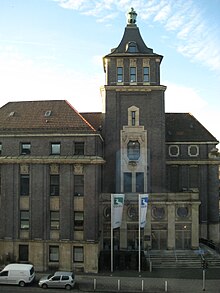Emschergenossenschaft
The Emschergenossenschaft is the oldest and biggest public German water board, („Wasserwirtschaftsverband”) located in Essen (North Rhine-Westphalia/Germany) and responsible for the 865 km2 Emscher catchment with 2.2 million citizens.
In Europe‘s largest urban area, between Dortmund and Duisburg as well as in the northern perimeter of the Lippe region, The Emschergenossenschaft offers modern, cost-effective water management that covers a broad range of responsibilities as sewage treatment, care and maintenance of waterways, natural remodelling of open waste water canals, flood protection, regulation of water flow and management of groundwater and rainwater Until the start of industrialization in the Ruhr region from the middle of the 19th century, the Emscher was a meandering lowland river around 109 km long, which was also dammed by many weirs on its tributaries and in the partly branched main stream.
The Emscher also had hardly any bridges or crossing facilities for a long time; the first north-south road link between the present-day cities of Recklinghausen and Herne, for example, was not built until 1842.
The wastewater from mining and the smelting works, but also from the settlements, collected here and putrefied: the population of the Emscher towns increased rapidly in the 19th century.
Any costs incurred were distributed proportionately among those responsible for wastewater or construction measures, i.e. mining, trade and industry as well as cities and municipalities (as representatives of the citizens).
The plan drawn up by government architect Wilhelm Middeldorf in 1901 "for the regulation of the receiving water and wastewater treatment in the Emscher region" predicted mining-related disruptions for the next 50 years with an assumed mining depth of up to 1,000 m.[6] On July 14, 1904, the Emschergenossenschaftsgesetz (Emscher Cooperative Act) was confirmed by Prussian King Wilhelm II and later served as a model for the establishment of other water management associations.
With the completion of construction work in this estuary delta in 2018, the Emscher will be relocated for a third time to the Voerd city area.
The increasing problems with the lack of gradient in the streams, which arose again and again due to the subsidence caused by mining, were solved in many places by pumping stations.
The Emschergenossenschaft can therefore "rebuild" the drainage system, i.e. the former streams are gradually freed from wastewater, which then flows into the treatment plants in underground pipes.
The reasoning stated that outside of direct state administration, in defined areas such as water management, special organizational forms of municipal self-administration are permissible for the performance of public tasks, especially as they are compatible with the democratic principle of the Basic Law in Article 20 (para.
The long-term increase in local heavy rainfall events can be statistically proven by the Emschergenossenschaft, as precipitation data has been collected throughout the catchment area since its foundation.
However, this has not been able to prevent flooding from local heavy rainfall events somewhere in the catchment area almost every year from the municipal sewage system or from exceeding the technically dimensioned volumes of retention basins, as there can be no absolute certainty.
Challenges continue to arise from so-called micropollutants, which have been present in wastewater for some time but are increasingly detectable thanks to ever-improving analytical methods.
The tasks are regulated in the Emschergenossenschaftsgesetz (Emscher Cooperative Act) and the articles of association and rules of procedure.
The former heads of the association: Wilhelm Middeldorf (1905 to 1911), Heinrich Helbing (1911 to 1933), Alexander Ramshorn (1934 to 1958), Erich Knop (1958 to 1974) since Wolfgang Türstig left 62 J to Gunther Annen (1974 to 1991) and Jochen Stemplewski (1992 to 2016).
The supervisory authority is the Ministry of the Environment, Agriculture, Nature Conservation and Consumer Protection, which is responsible for water management in the state of North Rhine-Westphalia.
The former parts of the catchment area in Duisburg and Oberhausen are drained artificially and the waste water is – after treatment – pumped into the river Rhine.

